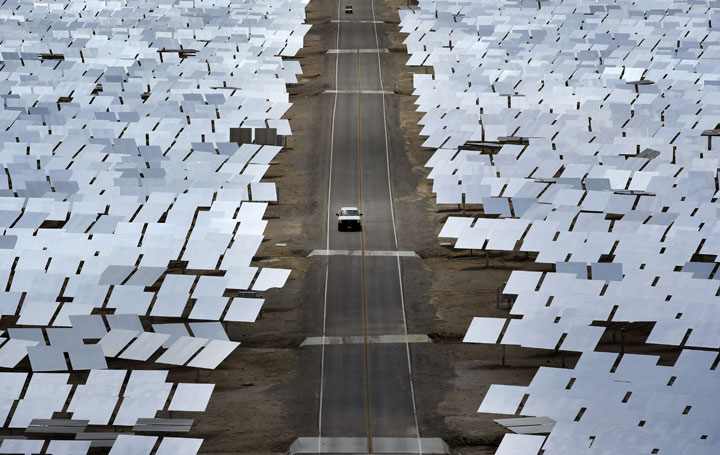Watch the video above: Aerial view of massive Ivanpah solar energy facility which uses more than 300,000 mirrors to take in the sun’s energy and make electricity.

TORONTO – A solar-power generating station in central California is killing birds as they catch fire in the reflection of light from its massive array of mirrors, and now there are concerns that initial estimates of bird losses are too low.
Workers at the $2.2 billion Ivanpah solar plant, which opened in December 2013, have a name for the birds unfortunate enough to be caught up in the mirrors’ light: streamers. This is due to the puff of smoke as the birds ignite in mid-air and fall to the ground.
READ MORE: Calgary company harnesses solar power for southeast retail centre
Instead of an estimated one thousand birds dying annually, that number could be as high as 28,000 a year, according to The Associated Press. And of particular concern to environmental groups is the planned project in another part of the state.
BrightSource, NRG Power and Google are all investors in the massive generating station.
The solar plant doesn’t produce energy the way traditional solar cells do. Instead 300,000 mirrors are spread across 3,500 acres at the Ivanpah Dry Lake where they reflect sunlight to boilers that sit on top of three 459-foot tall towers. There they fluid in the boilers’ pipes, creating super-heated steam. That steam is then piped from the boiler to a turbine that generates power, providing electricity to 140,000 California homes.
In April the U.S. Fish and Wildlife Service produced a report that chronicled their findings from three solar energy facilities in California, including Ivanpah.
“Ivanpah…produces solar flux, which is intense radiant energy focused by the mirror array on the power-generating station,” the report reads. “Objects that pass through this flux, including insects and birds, encounter extreme heat, although the extent of heating depends on many variables, including the duration of exposure and the precise location in the flux beam.”
A total of 141 dead birds were collected by officials over one year and five months, which included the construction phase. Of those, 47 died due to solar flux injury. The birds’ feathers were curled, charred, melted or broken.
The second most common cause of death at Ivanpah was impact trauma, believed to be caused when many of them collided with the mirrors. It could be because the mirrors reflected the blue sky which birds may have mistaken for water in the desert area.
- Ontario First Nation declares state of emergency amid skyrocketing benzene levels
- Singh mulls TikTok return as U.S. nears potential ban over security fears
- More financial institutes are offering crypto-services, survey shows
- Possible TikTok ban in U.S. looms after Biden signs bill, setting up legal fight
According to The Associated Press, with the new concerns raised, California’s energy commission attempting to determine whether pushing the limits of solar technology is worth the added damage to wildlife from the novel form of solar energy.
READ MORE: WATCH – Solar plane completes successful flight
Brightsource has plans to build another plant in Palen, California, that would be twice as big as Ivanpah.
“We need more data before any more of these projects get approved,” said Lisa Belenky, senior attorney for the Center for Biological Diversity.
“We need to understand more about how many birds will be killed and we need to understand more about potential ways to stop that, if it’s possible.”
The proposed tower would produce a flux area that would be more than three times as large as the existing towers at Ivanpah, Belenky explained. And that could possibly pose more danger to migratory birds that travel from the Colorado River and Salton Sea.
The Palen Solar Power Project is currently in front of the California Energy Commission.
There are no projects like this in Canada.
–with files from The Associated Press



Comments